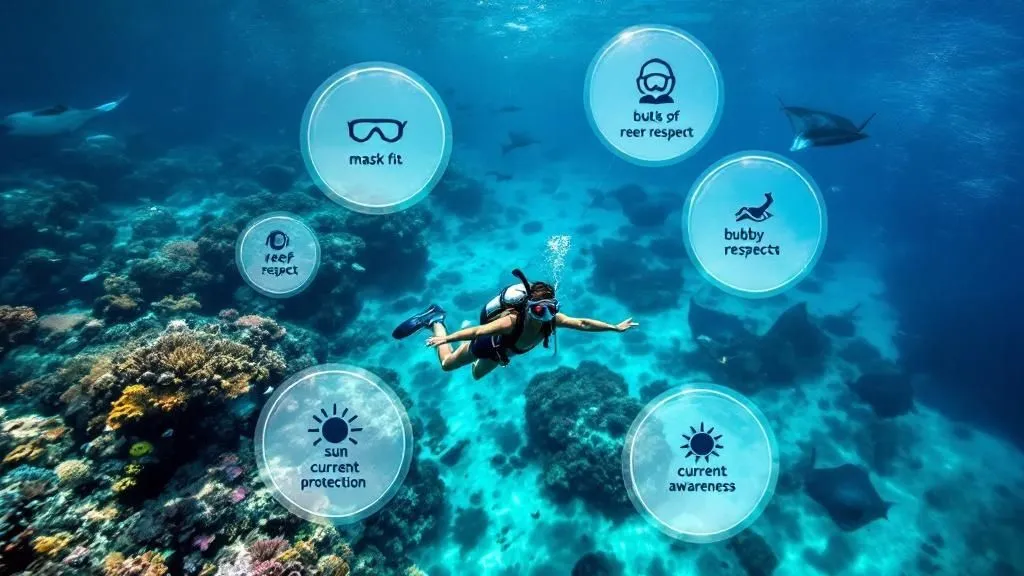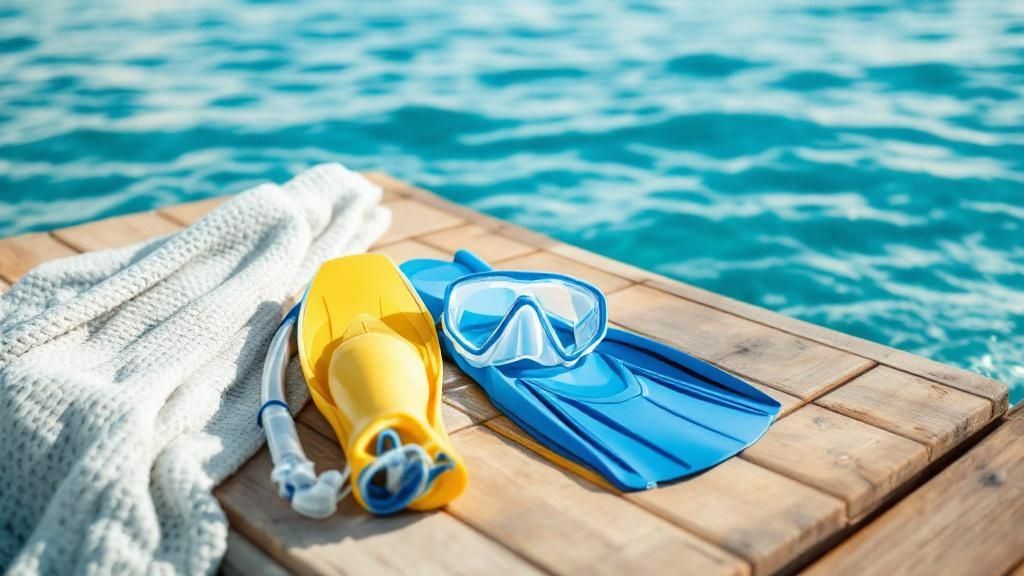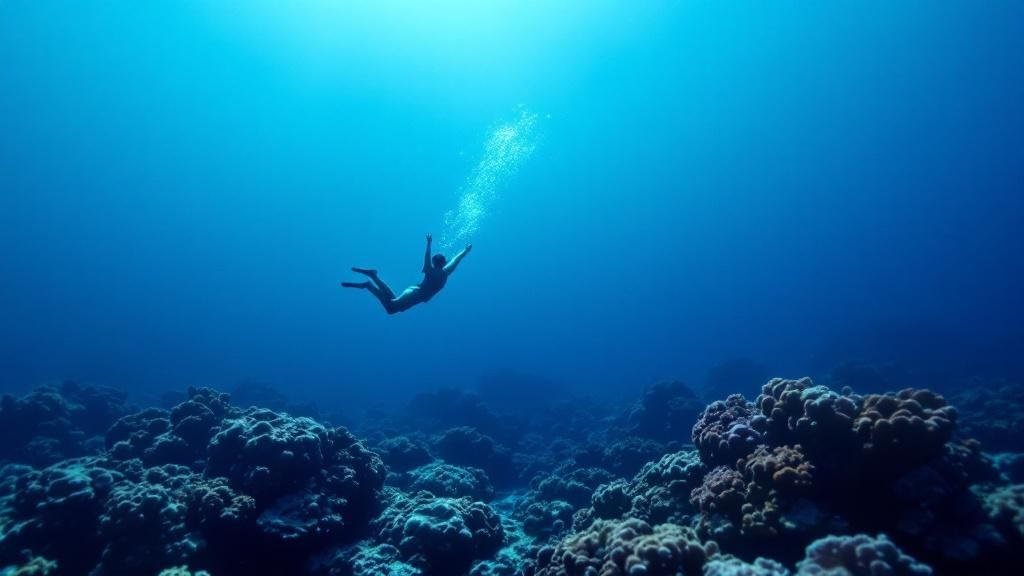6 Essential Snorkeling Safety Tips for 2025

Welcome to the vibrant underwater world of Kona, Hawaii! The Big Island's crystal-clear waters teem with life, from colorful coral reefs in Kealakekua Bay to the majestic manta rays on our famous night snorkel. At Kona Snorkel Trips, your safety is the foundation of every unforgettable memory we help create. While our lifeguard-certified guides are always by your side, empowering you with knowledge is key to a confident and joyful experience.
This guide moves beyond the basics, offering detailed and actionable snorkeling safety tips tailored for our unique Hawaiian environment. We'll cover everything from the non-negotiable buddy system to mastering your buoyancy and understanding local water conditions. These principles are designed to enhance your awareness and build your confidence in the water.
Whether you're a first-timer feeling the pre-snorkel jitters or a seasoned enthusiast, these six core principles will equip you to navigate the ocean with skill, respect, and peace of mind. Let's dive into the practices that transform a good snorkel trip into a great one, ensuring your focus remains on the breathtaking beauty around you. By understanding these key concepts, you can fully immerse yourself in the adventure safely and responsibly.
1. Never Snorkel Alone – Always Use the Buddy System
The single most important rule in water safety is also the cornerstone of our snorkeling safety tips: never go it alone. The buddy system is a non-negotiable pact between you and at least one other person. It’s a simple, yet profoundly effective, safety net where partners are mutually responsible for monitoring each other's location, well-being, and equipment throughout the entire time you are in the water. This isn't just a casual suggestion; it's a foundational principle adopted by every major dive and snorkel organization worldwide for a reason.
On a Kona Snorkel Trips tour, we facilitate this by ensuring all guests are paired up. However, understanding how to be a good buddy is crucial. The system works because it provides immediate assistance. Should you feel fatigued, get a leg cramp, or have an issue with your mask, your buddy is right there to help, signal for assistance, or provide a stable presence to lean on.
How to Implement the Buddy System Effectively
Being a good buddy is an active, not a passive, role. It requires pre-planning and constant communication. Before you even touch the water, take a few moments to establish a clear plan.
- Establish Clear Communication: Agree on simple, easy-to-understand hand signals. The "OK" signal (thumb and index finger forming a circle) is universal, but you should also have signals for "something is wrong," "I'm cold," or "let's go back."
- Set Proximity Rules: Decide on a maximum distance you'll stray from each other. A good rule of thumb is to always be close enough to make physical contact within a few seconds, typically no more than 10-15 feet apart.
- Conduct Pre-Snorkel Checks: Just like pilots do a pre-flight check, do a pre-snorkel "buddy check." Ensure your partner's mask strap is flat, their snorkel is secure, and their fins are properly fitted.
- Plan Your Snorkel: Briefly discuss your intended route and agree on a set duration or a "turnaround" point. This prevents one person from getting tired while the other wants to keep exploring.
Key Insight: The buddy system transforms snorkeling from a solitary activity into a shared, cooperative experience. It's not about restricting your freedom; it's about expanding your safety margin so you can explore with greater confidence and peace of mind.
2. Check Weather and Water Conditions Before Entry
The ocean is a dynamic and powerful environment that commands respect. One of the most critical snorkeling safety tips is to perform a thorough assessment of the weather and water conditions before you even think about getting in. This isn't just about glancing at the sky; it's a comprehensive evaluation of surf, currents, wind, and visibility. Conditions can change rapidly, and what looks calm from the shore can be a different story just a few feet out. Understanding these variables is key to preventing dangerous situations and ensuring your snorkel is enjoyable, not an emergency.

On our Kona Snorkel Trips, our experienced captains and crew handle this assessment for you, choosing locations with the best possible conditions for the day. However, for those snorkeling on their own, this skill is essential. For instance, Hawaii’s North Shore is a gentle paradise in the summer but becomes extremely dangerous with massive swells in the winter. Similarly, Caribbean waters can have poor visibility for days after a major storm. Recognizing these patterns is a non-negotiable part of safe snorkeling.
How to Implement Condition Checks Effectively
Making an accurate assessment involves using modern tools and old-fashioned observation. It’s an active process that begins long before you arrive at the beach and continues until the moment you enter the water.
- Consult Multiple Forecasts: Don't rely on a single weather app. Check multiple sources, especially marine-specific forecasts from services like NOAA (National Oceanic and Atmospheric Administration) that provide detailed information on swell height, wind speed, and tides.
- Observe First, Enter Second: Arrive at your snorkel spot and spend at least 10-15 minutes just watching the water. Look for the size of the waves, the direction of any currents (watch how seaweed or debris moves), and entry/exit points.
- Talk to Local Experts: If available, speak with lifeguards, local surf shops, or tour operators. They have invaluable, up-to-the-minute knowledge of the local conditions that no forecast can provide. For detailed guidance on this crucial step, you can learn how to effectively check ocean conditions for the Big Island.
- Have a Plan B: Conditions can be unpredictable. Always have a backup snorkeling spot in mind. If you arrive and the surf is too high or the water is murky, don't risk it. Simply move to your alternate, more protected location.
Key Insight: Checking the conditions isn’t about deciding if you will snorkel, but where and when you can do so safely. Being flexible and respecting the ocean’s power is a sign of a smart, experienced snorkeler, ensuring every outing is a positive one.
3. Proper Equipment Inspection and Maintenance
Your snorkeling gear is your life support system in the water, and treating it as such is a critical component of snorkeling safety. Proper equipment inspection and maintenance isn't just about prolonging the life of your gear; it's about preventing a minor malfunction from escalating into a serious emergency. A well-maintained kit functions predictably and reliably, allowing you to focus on the incredible marine life around you, not on a sudden equipment failure. This practice is a core principle emphasized by every reputable equipment manufacturer and dive agency.

On our Kona Snorkel Trips, we meticulously maintain our rental gear, but it's vital for every snorkeler to understand these checks. A surprise leak in your mask from a brittle strap, a snorkel purge valve that won't clear, or a broken fin strap that leaves you with reduced propulsion can quickly turn a relaxing float into a stressful situation. A simple pre-snorkel inspection is your first line of defense against these preventable issues.
How to Implement Effective Gear Checks
Making equipment inspection a non-negotiable part of your pre-snorkel routine takes only a few minutes but provides immense peace of mind. It’s a habit that separates a prepared snorkeler from a potential victim of circumstance.
- Inspect Your Mask: Check the silicone skirt for any tears or signs of becoming stiff and brittle. Test the seal by pressing the mask to your face without the strap and inhaling lightly through your nose; it should stay in place. Ensure the strap and buckles are in good condition.
- Test Your Snorkel: Examine the mouthpiece for any deep bite marks or tears that could cause leaking. If you have a dry-top or a purge valve, ensure it is clear of sand and debris and moves freely.
- Check Your Fins: Look for cracks or splits in the fin blade, especially where it meets the foot pocket. For adjustable-strap fins, inspect the straps for any signs of perishing rubber or cracks and test the buckles to ensure they lock securely.
- Care for Your Gear Post-Snorkel: Always rinse your equipment thoroughly with fresh water after every use. For a more detailed guide, you can learn more about how to clean snorkel gear on konasnorkeltrips.com. Store it in a cool, dry place away from direct sunlight, which can degrade silicone and plastic over time.
Key Insight: Your gear is a set of tools designed to make you comfortable and efficient in an alien environment. By ensuring these tools are in perfect working order before every entry, you are actively managing your risk and setting yourself up for a safe, successful, and stress-free snorkeling adventure.
4. Know Your Swimming Limits and Abilities
One of the most crucial, yet often overlooked, snorkeling safety tips involves an honest and realistic assessment of your own capabilities. The ocean is a powerful and unpredictable environment, and respecting its power begins with understanding your personal limits. This means being truthful about your swimming skills, physical fitness, endurance, and comfort level in open water. Your safety, and enjoyment, depend on choosing conditions and locations that align with your abilities, not your ambitions.

This principle is a core component of safety programs from organizations like the Red Cross and YMCA. It's not about being a weak swimmer or a strong one; it’s about making smart decisions. A beginner, for example, should stick to calm, shallow lagoons where they can stand if needed, while an experienced swimmer might be comfortable in choppier water or on a drift snorkel. On a Kona Snorkel Trips tour, our guides will always assess conditions, but your self-awareness is the first line of defense against getting into a situation that is beyond your control.
How to Assess and Respect Your Abilities
Being honest with yourself and your guide is the key to a positive experience. It allows for adjustments that ensure your comfort and safety without diminishing the adventure. Before you book a trip or enter the water, consider the following.
- Practice in a Controlled Environment: If you're unsure of your skills, spend time in a pool first. Practice breathing through the snorkel and using your fins. This builds confidence and muscle memory in a safe setting.
- Start Small and Shallow: For your first few ocean snorkeling experiences, choose very calm conditions and stay in water shallow enough to stand up in. This allows you to get comfortable with the equipment and the sensation of being in the open ocean.
- Gradually Increase the Challenge: As you become more confident, you can gradually venture into deeper water or for longer durations. Never make a huge leap in difficulty; incremental steps are the safest way to progress.
- Communicate Your Concerns: Always inform your guide or buddy about your comfort level. If you are a nervous swimmer or have a low fitness level, let us know. We can provide extra flotation, keep you closer to the boat, and offer personalized guidance.
Key Insight: Snorkeling is not a swimming competition. It's an observation activity. Using flotation devices like a pool noodle or a snorkel vest isn't a sign of weakness; it’s a smart tool that conserves energy, increases buoyancy, and allows you to relax and focus on the incredible marine life below.
5. Maintain Proper Buoyancy and Breathing Techniques
Mastering your breathing and buoyancy is the secret to transforming a potentially clumsy swim into an effortless, graceful glide through the underwater world. Proper technique isn't just about comfort; it's a cornerstone of snorkeling safety tips that conserves energy, calms the mind, and protects the delicate marine ecosystem you've come to admire. It involves breathing calmly and deeply through your snorkel and maintaining a flat, neutral position in the water, allowing you to float with minimal effort.
This control prevents two major risks: exhaustion from fighting the water and accidental damage to fragile coral reefs. By learning to be "one with the water," you become an observer, not an intruder. On our tours, we often see the most relaxed snorkelers have the best wildlife encounters because their calm, controlled presence is less intimidating to marine life.
How to Implement Proper Technique Effectively
Achieving this state of zen-like control is easier than it sounds. It begins with conscious practice and a focus on fundamental skills before you even venture into deeper water.
- Practice Calm Breathing: Before your tour, or in the shallow water at the start, simply place your face in the water and focus on taking slow, deep, and regular breaths through the snorkel. This builds confidence and prevents the shallow, panicked breathing that can lead to anxiety or hyperventilation. For a complete guide, you can learn more about how to breathe when snorkeling on our blog.
- Find Your Float: Lie flat on the surface, face down, and let your body relax. You should float naturally. If your legs tend to sink, a slight, gentle flutter kick from your hips (not your knees) is all you need to stay horizontal. The goal is to expend as little energy as possible.
- Learn to Clear Your Snorkel: Water will inevitably enter your snorkel. Instead of panicking, practice the two main clearing methods. The "blast clear" involves a forceful exhale (like blowing a cannon) to shoot water out the top. The "displacement clear" is used with purge-valve snorkels, where you simply exhale normally as you surface, and the water drains out the bottom valve.
- Minimize Movement: Great snorkelers are efficient. They use slow, deliberate fin kicks and keep their arms relaxed at their sides to be more hydrodynamic. This conserves precious energy, allowing you to stay in the water longer and more safely.
Key Insight: Excellent buoyancy and breathing are not advanced skills; they are foundational. They reduce physical strain, increase your time in the water, and ensure you leave the environment exactly as you found it. This conscious control is the ultimate mark of a responsible and confident snorkeler.
6. Sun Protection and Hypothermia Prevention
Managing your body's temperature is one of the most overlooked yet critical snorkeling safety tips. Snorkelers often focus so much on the world below that they forget about the powerful environmental forces above and around them: the intense tropical sun and the deceptively cool water. Effective protection against both sunburn and hypothermia is essential not just for comfort, but for preventing serious health issues that can abruptly end your adventure. Exposure to these elements is a dual threat that requires a proactive, two-pronged strategy.
On a Kona Snorkel Trips tour, we are hyper-aware of these risks. The Hawaiian sun can cause a severe burn in a surprisingly short time, especially with its rays amplified by the water's reflection. Simultaneously, even warm-looking tropical water, typically around 75-80°F, is well below your body temperature and will continuously draw heat away from you. This can lead to a gradual, often unnoticed, onset of hypothermia, causing fatigue, poor judgment, and muscle weakness.
How to Manage Sun and Cold Exposure Effectively
A smart snorkeler prepares for both extremes. This means layering protection and being vigilant about your body's signals throughout your time in the water. For enhanced awareness regarding environmental factors and your body's response, exploring top health tracking wearables can provide valuable real-time data to aid in sun protection and prevent hypothermia.
- Prioritize Reef-Safe Sunscreen: Apply a broad-spectrum, water-resistant, reef-safe sunscreen with an SPF of 30 or higher at least 20 minutes before entering the water. Pay special attention to your back, shoulders, neck, and the backs of your legs, as these areas face the sun directly while you snorkel.
- Wear Protective Clothing: A long-sleeved rash guard or a full-body "stinger suit" offers excellent, chemical-free UV protection and adds a slight layer of insulation. These garments are a snorkeler's best friend. For more details on this, see our complete snorkeling UV protection guide.
- Consider a Wetsuit: Even in Kona's relatively warm waters, a thin 3mm wetsuit can make a huge difference, especially during longer snorkel sessions or our famous Manta Ray Night Snorkel. It provides buoyancy, UV protection, and crucial insulation against gradual heat loss.
- Stay Hydrated and Take Breaks: Dehydration accelerates both heat exhaustion and hypothermia. Drink plenty of fresh water before and after your snorkel. Listen to your body; if you start shivering or feel excessively hot, get out of the water, dry off, and rest in the shade.
Key Insight: Protecting yourself from the elements is not about avoiding the environment, but about equipping yourself to enjoy it for longer and more safely. By managing sun and cold exposure, you maintain your energy, focus, and physical well-being, allowing you to fully immerse yourself in the underwater beauty with confidence.
Snorkeling Safety Tips Comparison
| Safety Practice | Implementation Complexity 🔄 | Resource Requirements ⚡ | Expected Outcomes 📊 | Ideal Use Cases 💡 | Key Advantages ⭐ |
|---|---|---|---|---|---|
| Never Snorkel Alone – Always Use the Buddy System | Moderate – requires partner coordination | Low – needs at least two people | High safety, immediate emergency assistance | All snorkelers, especially beginners | Immediate help, shared safety, enhanced confidence |
| Check Weather and Water Conditions Before Entry | Moderate – requires weather knowledge | Moderate – access to forecasts and tools | Safer snorkeling, optimized conditions | Planning snorkel trips, variable environments | Prevents hazards, improves visibility and comfort |
| Proper Equipment Inspection and Maintenance | Moderate – requires time and attention | Moderate – inspection tools, replacement | Reduced equipment failure, better performance | Regular snorkelers, rental gear users | Prevents failures, extends gear life, increases confidence |
| Know Your Swimming Limits and Abilities | Low – requires honest self-assessment | Minimal – self-evaluation | Prevents exhaustion and panic, safer snorkeling | Beginners, varying fitness levels | Reduces accidents, enables site-appropriate choices |
| Maintain Proper Buoyancy and Breathing Techniques | Moderate – needs skill development | Low – practice and instruction | Longer, comfortable sessions, less fatigue | All snorkelers aiming for skill improvement | Energy efficiency, environmental protection |
| Sun Protection and Hypothermia Prevention | Low to Moderate – requires preparation | Moderate – sunscreen, protective clothing | Prevents sunburn, heat exhaustion, hypothermia | All snorkelers, especially in extreme climates | Health protection, longer comfortable snorkeling |
Ready to Explore Kona's Waters with Confidence?
The vibrant coral gardens and majestic marine life of the Kona coast offer an experience that stays with you long after you've dried off. This comprehensive guide to snorkeling safety tips is designed not to intimidate, but to empower. Mastering these principles transforms your time in the water from a simple activity into a deeply enriching and secure adventure, allowing you to focus on the incredible beauty surrounding you.
The ocean is a dynamic environment, and treating it with respect is the cornerstone of safe exploration. Think of these guidelines as your personal toolkit for responsible adventure. By embracing them, you’re not just following rules; you are actively participating in your own well-being and that of those around you.
From Knowledge to Action: Your Safety Checklist
We’ve covered six critical pillars of snorkeling safety, each one a vital component of a successful and stress-free outing. Let’s briefly revisit the core takeaways you can implement on your very next trip:
- The Buddy System: This is non-negotiable. Your buddy is your immediate support system. Before entering the water, establish clear hand signals and a check-in frequency. This simple habit is your single most effective safety measure.
- Condition Awareness: Always make a habit of checking the weather and water conditions. Use reliable apps, check local reports, and most importantly, observe the ocean with your own eyes before you even think about getting in. If it looks too rough, it is.
- Gear Integrity: Your equipment is your life support. A five-minute pre-snorkel check of your mask strap, snorkel keeper, and fin buckles can prevent a frustrating or dangerous situation from developing in the water.
- Honest Self-Assessment: Knowing your personal swimming limits isn't a sign of weakness; it's a mark of a smart snorkeler. Be realistic about your energy levels and comfort in the water, and never push yourself beyond your capabilities.
- Mindful Technique: Proper buoyancy and calm, rhythmic breathing are the keys to energy conservation and a peaceful underwater experience. Practice floating effortlessly and breathing deeply and slowly. This skill reduces fatigue and keeps you relaxed.
- Elemental Protection: The Hawaiian sun is powerful, and the ocean can cool your body faster than you realize. Consistently applying reef-safe sunscreen and considering a wetsuit top or rash guard addresses both sun exposure and potential hypothermia.
Embracing these snorkeling safety tips demonstrates a profound respect for the ocean and for yourself. It’s about being prepared so you can be fully present. When you stop worrying about "what if" and instead focus on "what is," the true magic of Kona's underwater world reveals itself. You notice the subtle color shifts on a parrotfish, the gentle sway of a sea turtle, and the intricate patterns of the coral reef. Safety doesn’t limit your adventure; it unlocks it.
Ready to put this knowledge into practice with a team that prioritizes your safety and delivers an unforgettable experience? Kona Snorkel Trips builds every tour on a foundation of expert guidance and personalized attention in our small-group settings. Join us and discover the underwater wonders of Kona with the ultimate peace of mind.
Book Your Safe and Spectacular Kona Snorkeling Adventure Today!
